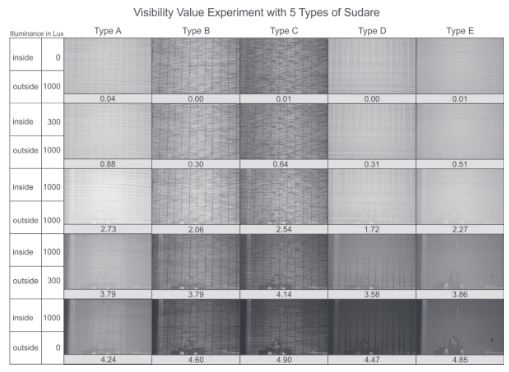Study of Visibility Indices of Traditional Japanese Horizontal Blind “Sudare” Based on the Illuminance Different Level Using Physical and Digital Image Experiment
Keywords:
Façade, Visibility, lluminance, Blind, Efficient energyAbstract
Sudare is a traditional Japanese blind made from bamboo. It has been used in Japanese houses for a long time, especially in summer. Its original function was to prevent direct solar radiation from entering a room, and to introduce outside air into a room at the same time. As an element of building, Sudare has the other function of creating space for different activities that need different levels of privacy. The characteristic form of Sudare makes it possible to see objects outside the house. During daytime, it is possible to see clearly the outside environment from inside but still maintain privacy from outside to inside. The privacy level is determined by the visibility level between each space, or from outside to inside, which are separated by partitions. At the same time, Sudare as a shading device can reduce thermal energy consumption. This study aims to evaluate the effect of the diameter, spacer, scale, and whiteness of Sudare on the level of visibility by comparing people’s responses by means of a questionnaire using physical and digital images experiment with different conditions of illuminance level. The results of the questionnaire using physical and digital image experiments indicate that both the experiments showed the same trend. The illuminance ratio is the main factor that affects the visibility value. A higher ratio of illuminance difference between the observer’s room and the object room will increase the value of visibility. The physical characteristics of Sudare (diameter, spacer, and scale) also influence the visibility value. Small scale Sudare have a better visibility value in a low illuminance ratio whereas large scale Sudare have better visibility value in high illuminance. High visibility value can be achieved when the illuminance ratio is more than 4.30.Downloads
References
Carlucci, S., Causone, F., De Rosa, F. & Pagliano, L. (2015). A review of indices for assessing visual comfort with a view to their use in optimization processes to support building integrated design. Renewable and Sustainable Energy Reviews, 47, 1016–1033. DOI:10.1016/j.rser.2015.03.062.
Chambers, N. (2014). CTBUH technical paper. CTBUH Journal, 2, 6–12. Retrieved from http://ctbuh.org/Portals/0/Repository/Chambers_2014_IsNetZero.dc063afd-e0b8-4332-873e-c191d4c3a335.pdf.
Chirarattananon, S. & Taveekun, J. (2004). An OTTV-based energy estimation model for commercial buildings in Thailand. Energy and Buildings, 36(7), 680–689. DOI: 10.1016/j.enbuild.2004.01.035.
Hariyadi, A., Fukuda, H. & Ma, Q. (2017). The effectiveness of the parametric design “Sudare” blind as external shading for energy efficiency and visibility quality in Jakarta. Architectural Engineering and Design Management. DOI:10.1080/17452007.2017.1296811.
Hariyadi, A., Suryabrata, J. A., Fitriana, A. N. & Fukuda, H. (2015). Performance based façade design study of department of public affair building complex in Jakarta Indonesia. Journal of Asian Urban Environment, 7–12.
Paryudi, I., Fenz, S. & Tjoa, A. M. (2013). Study on Indonesian Overall Thermal Transfer Value (OTTV) Standard. Int. J. of Thermal & Environmental Engineering, 6(2), 49–54. DOI:10.5383/ijtee.06.02.001.
Radhi, H., Sharples, S. & Fikiry, F. (2013). Will multi-facade systems reduce cooling energy in fully glazed buildings? A scoping study of UAE buildings. Energy and Buildings, 56, 179–188. DOI:10.1016/j.enbuild.2012.08.030.
Ruggiero, F., Florensa, R. S. & Dimundo, A. (2009). Re-interpretation of traditional architecture for visual comfort. Building and Environment, 44(9), 1886–1891. DOI:10.1016/j.buildenv.2009.01.006.
Tagliabue, L. C., Buzzetti, M. & Arosio, B. (2012). Energy saving through the sun: Analysis of visual comfort and energy consumption in office space. Energy Procedia, 30, 693–703. DOI:10.1016/j.egypro.2012.11.079.
Vijayalaxmi, J. (2010). Concept of Overall Thermal Transfer Value (OTTV) in design of building envelope to achieve energy efficiency. International Journal of Thermal and Environmental Engineering, 1(2), 75–80. DOI:10.5383/ijtee.01.02.003.
Yagi, K. (1982). A Japanese touch for your home (First). New York: Kodansha International.

Downloads
Published
How to Cite
Issue
Section
License
Copyright (c) 2017 International Journal of Building, Urban, Interior and Landscape Technology (BUILT)

This work is licensed under a Creative Commons Attribution-NonCommercial-NoDerivatives 4.0 International License.











